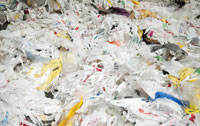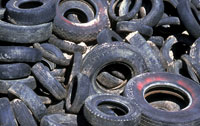Despite the best efforts of governments, consumers and industry, little more than half of the plastics that we use in everyday life is recovered – and much of it still ends up in landfill.
According to European Plastic Recyclers, which represents plastic mechanical recycling companies, Europe generated around 25m t of post-consumer plastics waste in 2008. In the same year, it converted around 50m t of virgin plastic into products. Of the waste, 51% was recovered. From this 12.8m t, 5.3m t was mechanically recycled and 7.5m t processed by energy recovery. For nations at the top of the recovery list – such as Germany and Switzerland – energy recovery accounts for most of the re-use of plastics.
Of course, we have been forced to improve our recycling efforts because the volume of plastics has mushroomed: in 1950, says EuPR, global plastics production was 1.5m t; by 2008, that figure had ballooned to 245m t.
EuPR separates recycling into three broad types: mechanical, chemical and energy recovery. Energy recovery is simply burning the shredded plastic to use it as a fuel; mechanical recovery grinds up products such as PET bottles or PVC pipes, and uses the material to make new products. PET bottles have been turned into PET fibres for clothing and even carpets, for example.
At its simplest, mechanical recycling happens within a plastics factory: off-cuts from the production process are simply fed back into the machine to make the next batch of products.
But the real issue is what to do with consumer goods – food packaging, toys, medical instruments, car components – once they are discarded. Europe processes around 50m t of plastics into products each year. At the same time, around 25m t of plastics find their way into the waste stream.

But as plastics processing techniques improve, more sophisticated products can be made – at least partially – from recycled plastics. A growing trend is to make exactly the same product, for a second time. An example is PVC window frames. They can now be made using a ‘core’ of recycled PVC encased in a shell of virgin polymer, which ensures colour stability. The machinery to make these products is quite specialised – and so far, sales of these windows are still small – but one manufacturer, Veka UK, is confident that they will take off. It recently developed its Infinity model, which uses 80% recycled material. The recyclate comes from Veka’s own reprocessing centre, where it recycles PVC window frames.
Plastic pipes giant Wavin has done something similar. Its Recycore technology makes PVC pipes using 50% recycled material – which is contained within a middle layer. The company says that the pipes have identical mechanical properties to those made from virgin material, and are the same price.
But waste plastic has also been used to create completely new products. A large-scale example of this was recently seen in Dubai: donated plastic rubbish was collected and converted into ‘plastic reefs’ – which were sunk into the Arabian Gulf in order to replace lost coral reefs. The reef is also expected to protect the shoreline from erosion and tidal damage.
But a growing – and far more powerful – method of recycling is chemical recovery. This is sometimes called monomer recovery, and is increasingly used as a way of recovering useful materials from plastic waste. It breaks the polymers back into their constituent parts – hydrocarbons – so that they can be used as fuel, or even re-polymerised.
One technique, called T-Technology, was developed by Polish-Hungarian company Pinter & Tokarz. The technique is called Polymer Energy outside Europe, due to a tie-up with US company Northern Technologies.
‘In Poland, around 1.4m t of waste goes to landfill, of which about 100,000 t is artificial materials,’ says Zbigniew Tokarz, ceo of Pinter & Tokarz. ‘After depolymerisation, it can become a component for the production of liquid fuels.’
The technique uses polyolefins – the most abundant and commonly used type of plastic – as raw materials, and converts them into light fractions of fuel oil: typically C5 to C34. Typical products that can be handled include plastic shopping bags, food packaging, toys, some types of plastic pipes, and vehicle parts such as bumpers.
The plastic waste stream needs to be restricted to cleaned polyolefins (polypropylene and polyethylene). However, up to 15% contamination such as paper, sand or water is acceptable. The mixture is then catalytically pyrolysed in an airtight atmosphere, in order to break down the polymer chains.
A typical plant converts each kg of plastic waste into 0.78kg of final product (or 720 litres/t). Each unit produces around 300 litres of oil/hour. The technology has been adopted around the world. One of the most recent installers was the Hua Hin landfill site in Thailand. The local municipality estimates that 10% of the 400,000 t of rubbish in the site is plastics waste. If it could all be collected and converted, this would equate to 29m litres of oil. The installation is due to be completed by the end of 2011.
Closer to home, Sita UK has received approval to build a plastics-to-diesel facility in Bristol – which it says would be the first in the country. The company plans to build a ‘resource recovery park’ that will extract energy from mixed waste, to reduce the amount of rubbish sent to landfill. A key part of the park will be the conversion of waste products like yoghurt pots and meat trays into diesel fuel. At full capacity, it would produce around 4.2m litres of diesel/year, from 6000 t of plastic.
The plant is slated to open in 2013, and could be the first of many. Sita will use technology from Irish company Cynar – after signing a deal with the company in 2010. Each Cynar plant can process up to 20 t of mixed waste plastics/day, producing up to 19,000 litres of fuel products at a conversion rate of 95%.
‘We aim to build around 10 facilities in the first tranche of development that will convert waste plastic into diesel fuel,’ says David Palmer-Jones, ceo of Sita UK.
But this 10-plant deal seems to pale into insignificance beside a more recent US announcement: a 10-year deal between JBI of Canada, and packaging giant Rock Tenn.
JBI will now be able to build its Plastic2Oil processing plants at Rock Tenn facilities, which are hoarding a growing stockpile of plastics. As well as generating plastics waste from its paper mills, Rock Tenn already operates a number of material recovery facilities.
JBI will also be able to ‘mine and process plastic from Rock Tenn’s mono-filled plastic sites’. This basically means that it has access to an enormous hole that Rock Tenn has been filling with plastics – and nothing else – for the last few years. The company claims a 90% conversion rate of plastics to fuel. A further 8% is released as gases – such as methane and ethane – which are compressed and stored. The remaining 2% of solids can be landfilled.
The technique has an advantage over others, claims JBI, in that the raw material does not need to be washed or processed in any way. It takes mixed plastic waste and converts it into diesel, heating oil and light naphtha fuels.
But there is something else that can be done with waste plastic: turn it into another plastic. It may sound like the polymer equivalent of alchemy, but researchers at University College Dublin, led by Kevin O’Connor, are looking to identify micro-organisms that can convert waste plastic into a biodegradable polymer called polyhydroxyalkanoate (PHA).
PHA is actually a group of bio-derived polyesters (including PHB, polyhydroxybutyrate) that are already produced commercially: US company Telles, for example, has a polymer called Mirel. When Telles makes Mirel, it starts from corn starch, using genetically engineered microbes to convert the sugar directly into plastic, which is then separated out and formulated into resins. O’Connor’s idea is that plastic waste – primarily PE or PET – will be ‘digested’ by the team’s own microbes and converted into PHA. First – as with other forms of chemical recycling – the waste must be pyrolysed in order to break it down.
In the case of PET, it is pyrolysed at 450oC, which produces solid, liquid and gaseous fractions. The liquid and gas are burnt for energy, but the solid fraction – which contains terephthalic acid (TA) – is used as the feedstock for bacterial production of PHA.
TA is not normally degraded by bacteria, but the team isolated 32 bacteria strains from soil, and found that three of them would convert TA into PHA. The bacteria came from soil that had been exposed to PET granules, at a PET bottle processing plant.) O’Connor’s lab has also looked at the possibility of converting the most common plastic, PE, into PHA, by first pyrolysing it into a wax. It has also successfully converted styrene oil – from pyrolysed polystyrene – into PHA in a similar way.
If successful, the method could provide a new way of making PHA that does not rely on growing crops, such as corn, specifically for the purpose. The project, which is supported by the Irish Environmental Protection Agency’s Strive programme, will attempt to optimise the bioprocess, scale it up, and characterise and produce the polymers.
Plastics are an inescapable fact of modern life. They solve many problems – giving us lighter cars and planes, stylish consumer products and effective food packaging. Disposing of plastics is a problem that is not going away, but some of the newer chemical techniques are playing their part to solve it.
Europe's first large scale tyre pyrolysis plant for the UK
If there is one polymer that demands attention, it is rubber. In the EU-27 countries, an incredible 2.5m t of car tyres reached the end of their lives in 2009. That is a lot of rubber to shred and re-use.

UK company Pyreco is planning to process 60,000 t/year of tyres, at a new plant on Teesside, in order to extract gases, oils and carbon black. Pyreco says that the plant, which is due to open in 2012, will be Europe’s first large-scale tyre pyrolysis plant. It is being built at Wilton International chemical park, which hosts a number of chemical businesses.
In the first instance, the pyrolysis products will be used to create energy, but in the longer term they could be used as feedstocks.
Lou Reade is a freelance writer based in Kent, UK.





